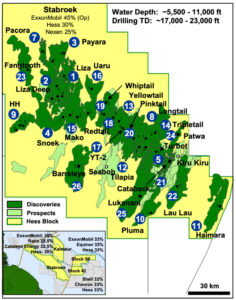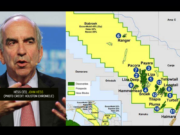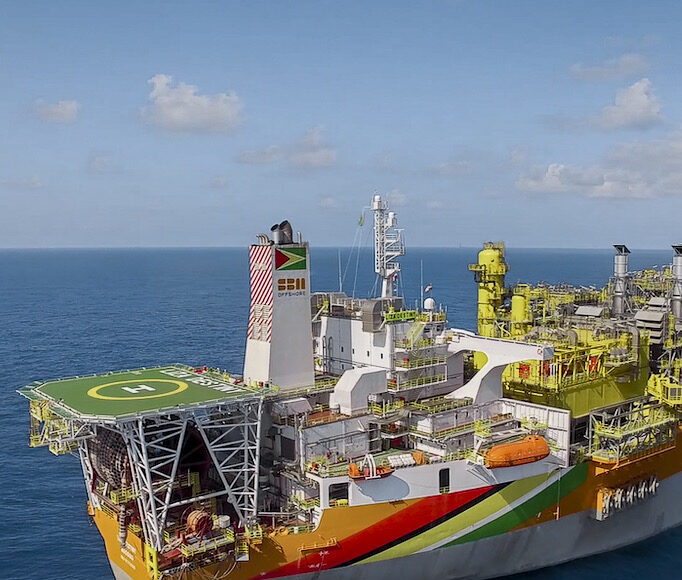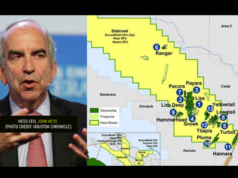By Sueann Wickham
Since its first oil find in the Stabroek Block in 2015, United States (US) oil major, ExxonMobil has made more than 32 discoveries significant discoveries offshore Guyana, and the small South-American nation is now potentially sitting on a multi-trillion dollar gold mine.
Since its 2015 discovery, the company has initiated six development projects which in total are expected to produce 1.2 million barrels per day by 2027.

Liza Phase 1 marked a significant moment, introducing the Liza Destiny FPSO to the Liza field, boasting a resource base of over 450 million barrels of oil equivalent. It involved 17 development wells, with first oil achieved in December 2019, reaching an oil production capacity of 150,000 bpd, and an FPSO oil storage capacity of 1.6 million barrels, with offloading occurring every 5 to 10 days. The estimated development cost was around US$3.6 billion.
Continuing their endeavors, Liza Phase 2 introduced the Liza Unity FPSO, still focused on the Liza field, this time with a resource base of 600 million barrels of oil equivalent. It entailed the development of 33 wells, with first oil flowing in February 2022, reaching an oil production capacity of 230,000 bpd, and an FPSO oil storage capacity of 2 million barrels. Offloading operations were streamlined to every 4 days, and the project had an estimated development cost of approximately US$6 billion.
The Payara project, soon to initiate production will be instrumental, and will feature the Prosperity FPSO, targeting the Payara and Pacora fields. The resource base extends to 600 million barrels of oil equivalent, with a network of 35 to 45 development wells. The expected first oil is in the latter part of 2023, with a production capacity of 220,000 bpd. The FPSO’s oil storage capacity is substantial at 2 million barrels, and offloading is projected every 4 days, with an estimated development cost of US$9 billion.
Looking ahead, the Yellowtail project is also on the horizon, involving the hull for the FPSO, named ONE GUYANA. The resource base for the Yellowtail and Redtail fields is an impressive 925 million barrels of oil equivalent, and it anticipates the establishment of 45 to 55 wells, with first oil expected in 2025. The oil production capacity is set at 250,000 bpd, and the FPSO features an oil storage capacity of 2 million barrels, with offloading operations projected every 4 days. The development cost for Yellowtail is estimated at US$10 billion.
The Uaru project is set to utilize MODEC’s M350 – Next Generation new build hull for its FPSO. The resource estimates for the Uaru, Mako, and Snoek fields account for 800 million barrels of oil. The development features 40 to 76 wells, with first oil expected in 2026 and a robust oil production capacity of 250,000 bpd. The FPSO boasts an oil storage capacity of 2 million barrels, with offloading operations estimated every 4 days and a development cost of approximately US$12.7 billion.
For the Whiptail project, ExxonMobil has reserved an SBM Offshore multi-purpose floater hull for a future Guyana FPSO, focusing on the Whiptail, Pinktail, and Tilapia fields. The resource base is estimated to be approximately 1 billion barrels of oil equivalent. The project involves 33 to 72 development wells, with first oil anticipated between late 2027 and early 2028, aiming for an oil production capacity of 250,000 bpd. An FPSO with an oil storage capacity of 2 million barrels is planned, with offloading operations estimated to occur approximately every 3 to 6 days. The development cost for Whiptail is substantial, with an estimated US$12.9 billion. These milestones reflect Exxon’s ongoing commitment to the development of Guyana’s oil resources, with each project marking a significant step in the region’s oil and gas industry.
According to Bloomberg, the current Brent Crude price at $90.89 and with Guyana set to be producing 1.2 millions barrel per day by 2027, it is safe to say that the country may see over a trillion dollars ($109,068,000) from its crude.
Guyana is poised to continue outperforming its Caribbean counterparts in economic growth this year, proving that it is indeed one of the fastest-growing economies in the world.
This also means good prospects for Guyana’s Gross Domestic Product (GDP) which according to a recently published report by the International Monetary Fund (IMF) titled Regional Economic Outlook was the world’s highest real GDP growth in 2022 at 62.3 percent and is continuing to rapidly increase this year – with an estimated increase of 38.4 per cent in 2023 and 26.6 per cent in 2024.









